In the previous article, we introduced about the bathroom mirror cabinet in the mirror shopping guide, and now this article is to introduce you to the bathroom mirror cabinet in the “cabinet” design. Bathroom mirror cabinets play a pivotal role in modern interior design, combining functionality and aesthetics. As both a storage solution and an improvement to the visual aesthetic of a space, bathroom mirror cabinets have become an integral part of the contemporary bathroom. In this comprehensive guide, we will explore the various design, functional and practical considerations of mirror cabinets so that you can find the ideal mirror cabinet solution to meet your space utilisation or ambience creation goals. Join us on our journey today and discover your perfect match!
1. Exploring Bathroom Mirror Cabinet Doors: Materials and Opening Styles
Bathroom mirror cabinets are an integral component of bathroom decor, providing storage space while adding their own distinct flair. Doors for bathroom mirror cabinets come in various materials and opening styles to give your space its desired style. Material and opening mechanism of bathroom mirror cabinet doors should also be carefully considered when making your decision. You can select from glass, stainless steel or wood options depending on personal taste and space constraints. Cabinet doors can open in various ways, such as sliding, swiveling and folding. Each type has its own set of advantages. No matter your style – from modern minimalist to traditional classic – you are sure to find the ideal cabinet door for your bathroom space, adding both practicality and beauty. This section explores materials and opening styles of cabinet doors so as to help guide you through them all.
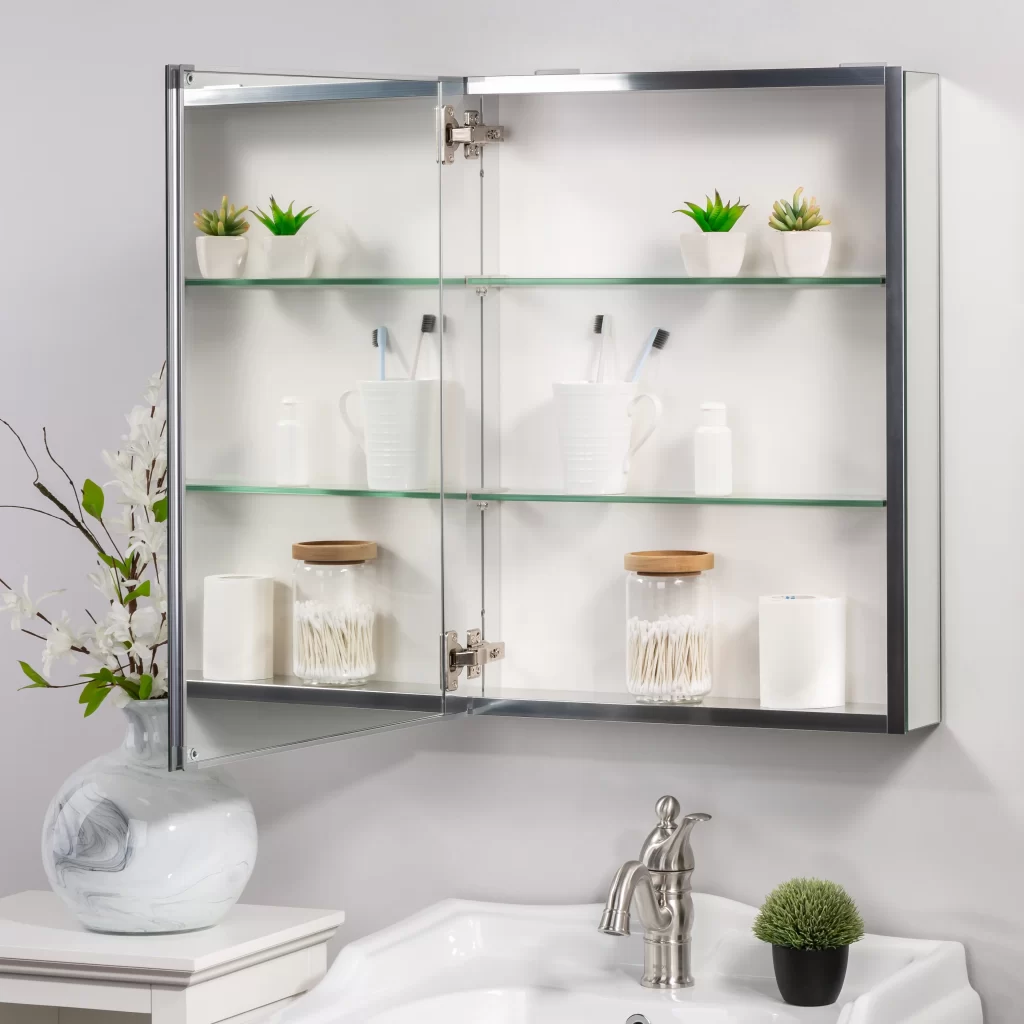
1.1. Exploring the Essentials: A Guide to Bathroom Mirror Cabinet Door Materials
Choosing the right material for your bathroom mirror cabinet doors is a critical decision that can significantly impact both the functionality and aesthetics of your space. The material not only influences the cabinet’s durability and maintenance requirements but also plays a key role in defining the overall style and ambiance of your bathroom. From timeless classics to innovative modern options, the range of materials available for cabinet doors is vast, each with its own unique characteristics and benefits. In this chapter, we explore the various materials commonly used for bathroom mirror cabinet doors, providing insights into their pros and cons to help you make an informed decision tailored to your preferences and needs.
1.1.1. Glass:
Glass is a versatile and modern material commonly used for bathroom mirror cabinet doors. Its high transparency creates a sense of space, making it ideal for enhancing the visual appeal of contemporary bathrooms. Easy to clean and resistant to dirt accumulation, glass offers a sleek and modern aesthetic.
- Advantages: High transparency creates a sense of space; easy to clean, resistant to dirt accumulation; modern aesthetic suitable for contemporary bathrooms.
- Disadvantages: Fragile, requires careful handling; fingerprints and water spots are easily visible, necessitating frequent cleaning; lacks privacy.
- Maintenance Requirements: Regular wiping to maintain cleanliness; avoid using abrasive cleaners to prevent surface scratches.
- Suitable Applications: Ideal for modern minimalist bathrooms and smaller spaces aiming to enhance spatial perception.
1.1.2. Wood:
Wood is a classic and elegant material often used in bathroom mirror cabinet doors. Known for its natural beauty, wood can bring warmth and a welcoming ambiance to any bathroom setting. It is available in a variety of wood types, such as oak, maple, and walnut, allowing for customization to match different style preferences.
- Advantages: Natural beauty brings warmth to the ambiance; durable, provides long-lasting usage; various wood options available to cater to different style preferences.
- Disadvantages: Susceptible to swelling or warping when exposed to moisture; requires regular maintenance such as waxing or painting; higher cost.
- Maintenance Requirements: Regular waxing or painting to preserve appearance; avoid prolonged exposure to moisture.
- Suitable Applications: Suited for those seeking traditional, vintage, or rustic bathroom styles, and those looking to introduce natural elements into their space.
1.1.3. Metal:
Metal is a contemporary material known for its strong aesthetic and durability. It is commonly used in modern or industrial-style bathroom mirror cabinet doors, providing a sleek and sturdy look.
- Advantages: Strong modern aesthetic, suitable for industrial-style bathrooms; sturdy and durable, resistant to damage; easy to clean, less prone to dirt accumulation.
- Disadvantages: May rust or oxidize, especially in humid environments; susceptible to scratches; higher cost.
- Maintenance Requirements: Regular cleaning to prevent dirt buildup; periodic application of rust-proofing agents to extend lifespan.
- Suitable Applications: Ideal for modern, industrial, or minimalist bathrooms, and those requiring high durability such as in public restrooms.
1.1.4. Composite Materials:
Composite materials are engineered to mimic the appearance of various natural materials while providing enhanced durability and versatility. These materials are commonly used in budget-friendly bathroom mirror cabinet doors.
- Advantages: Versatile, can mimic the appearance of various materials; high durability, resistant to damage; relatively lower cost.
- Disadvantages: Prone to scratches or discoloration; may contain harmful substances; appearance may not match that of natural materials.
- Maintenance Requirements: Regular cleaning to maintain appearance; avoid using abrasive cleaners to prevent surface scratches.
- Suitable Applications: Suited for consumers seeking diverse options at a lower price point, and those less concerned about the authenticity of materials.
1.1.5. Other Materials:
Suitable Applications: This section can discuss less common materials such as mirrored doors or acrylic doors, highlighting their unique characteristics and applications. For example, mirrored doors can enhance the sense of space, while acrylic doors offer lightweight and easy cleaning properties.
Each material offers unique benefits and challenges, affecting user experience and practicality. Wood is perfect for traditional aesthetics, metal for modern durability, composite materials for versatility and affordability, while other materials like mirrored and acrylic doors provide specific functional benefits. Understanding these aspects can help in choosing the right material to match your style and maintenance preferences, ensuring a well-suited and long-lasting bathroom mirror cabinet door.
1.2. Exploring Bathroom Mirror Cabinets: From Materials to Opening Mechanisms
In our last chapter, we explored various material choices for bathroom mirror cabinets ranging from glass to metal, wood, and composite materials – each offering distinct advantages that cater to different bathroom styles and preferences. Now let’s delve deeper into bathroom mirror cabinet design – specifically how opening mechanisms affect its functionality as well as aesthetic appeal – by exploring them more in-depth. Join us as we examine their characteristics and potential applications:
1.2.1. Swing Doors
Swing doors are hinged to the cabinet and can open in one or multiple directions.
a. Advantages:
- Simple and practical, easy to use.
- Provide full access to storage space.
- Traditional and familiar design, often considered aesthetically pleasing.
- Strong and durable, offering a sense of solidity and reliability.
b. Disadvantages:
- Require sufficient space in front of the cabinet to open fully, which can be limiting in small bathrooms.
- Can obstruct pathways when open, potentially reducing the functionality of the bathroom space.
- Suitable Applications:
- Ideal for larger bathroom spaces that can accommodate the swinging motion of the doors.
- Suitable for traditional or classic bathroom designs where space is not a constraint.
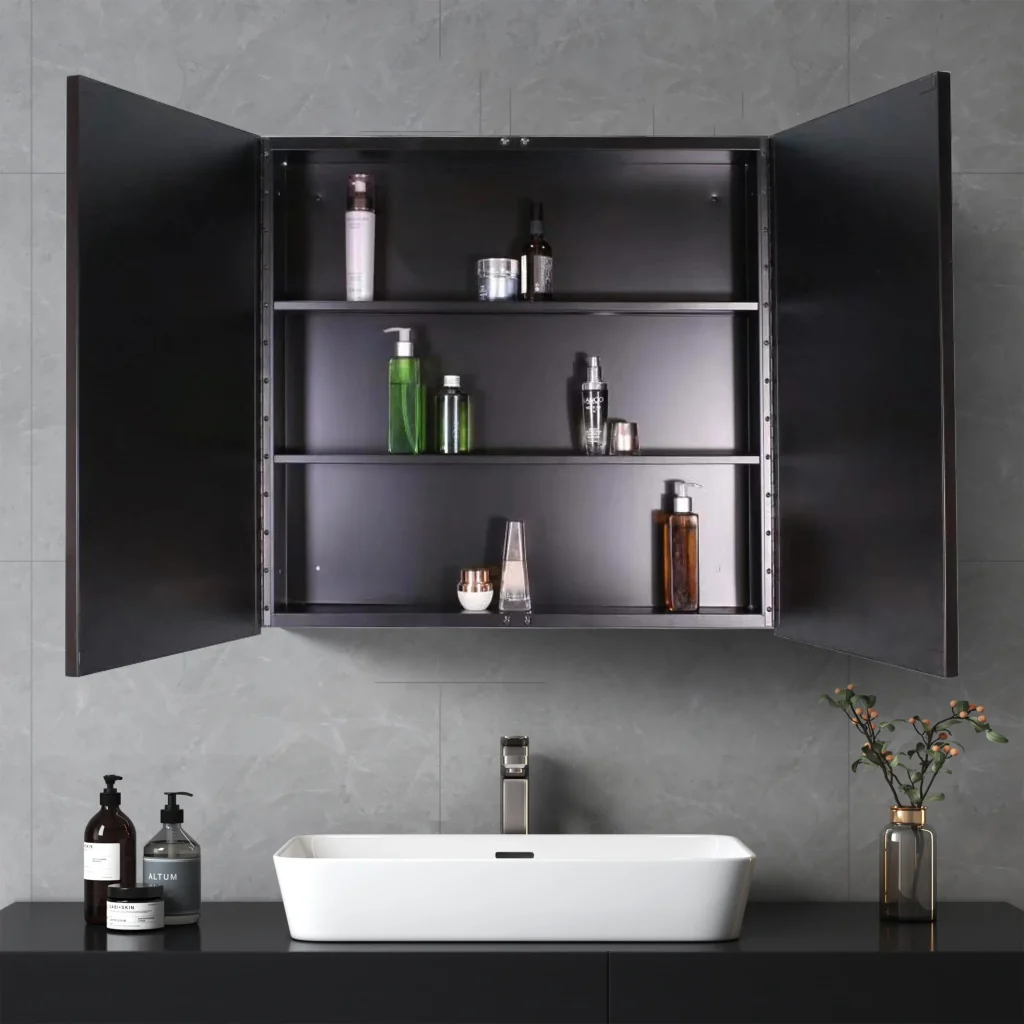
1.2.2. Sliding Doors
Sliding doors move along a track instead of swinging open.
a. Advantages:
- Space-saving, as they do not require extra space for opening.
- Suitable for small or narrow bathrooms where maintaining clear pathways is essential.
- Provide a sleek, modern look and can be easier to operate in tight spaces.
b. Disadvantages:
- Limited access to storage space at any one time, as part of the cabinet remains covered.
- Tracks can collect dust and require regular cleaning to ensure smooth operation.
- Potential for tracks to wear out over time, requiring maintenance or replacement.
- Suitable Applications:
- Best for narrow bathrooms or situations where space optimization is crucial.
Ideal for contemporary or modern bathroom designs where a streamlined look is desired.
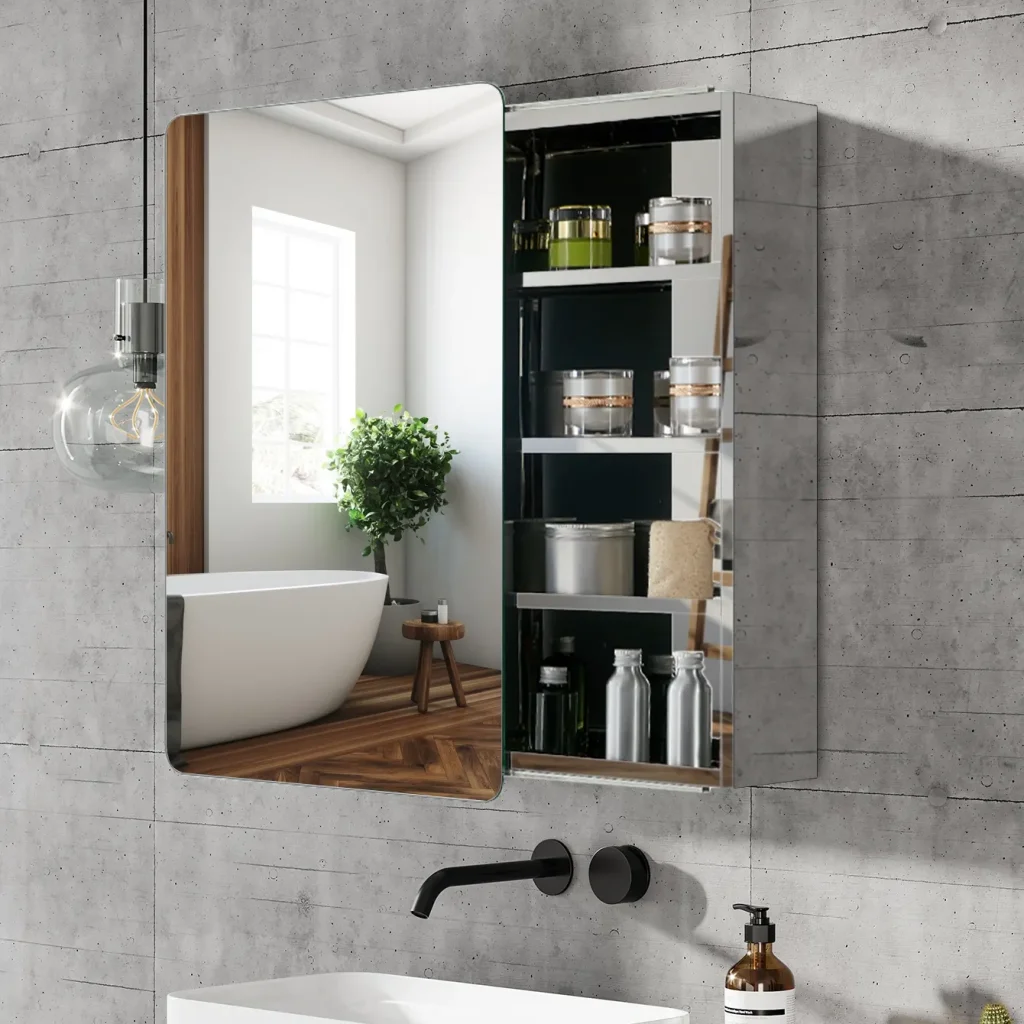
1.2.3. Frameless Doors:
Frameless doors lack external frames, presenting a continuous surface.
a. Advantages:
- Sleek and modern, providing a larger mirror surface area.
- Easy to clean, with fewer crevices for dirt and grime to accumulate.
- Offers a minimalist aesthetic, ideal for contemporary bathroom designs.
- Can make the bathroom appear larger and more open.
b. Disadvantages:
- Can be more expensive than framed options due to the precision required in their construction.
- May be less durable than framed doors, as the lack of a frame can make the glass more vulnerable to damage.
- Installation can be more complex, often requiring professional assistance.
c. Suitable Applications:
- Perfect for bathrooms with a contemporary minimalist style.
- Appealing to those aiming to maximize mirror area and create a seamless look.
Each door style contributes uniquely to the functionality and aesthetics of the bathroom. The choice depends on the specific needs and design preferences of the user, balancing practicality with visual appeal.
2. Exploring Cabinet Materials and Design for Bathroom Mirror Cabinets
In the previous section, we explored the different cabinet door materials and opening styles for bathroom mirror cabinets, choices that are crucial to the decor and practicality of your bathroom. Now, we will continue to delve into the design details of bathroom mirror cabinets, focusing on cabinet quality and exterior design. The cabinet is not only the supporting structure of the mirror cabinet, but also plays an important role in decorative and functionality. From solid wood to metal, from minimalist to luxury, we will explore a variety of materials and design styles to add more glamour and practicality to your bathroom.
2.1. Choosing the Best Bathroom Mirror Cabinet Materials: Style and Function
Selecting the ideal cabinet body material when designing a bathroom mirror cabinet is crucial. Different materials not only influence its look and feel but also its durability and suitability. In this chapter, we will examine some commonly used materials like solid wood, stainless steel, aluminum alloy, and powder-coated iron, exploring their features, advantages, disadvantages, and application scenarios. This will help you select an aesthetically pleasing yet practical mirror cabinet for your bathroom space.
2.1.1. Solid Wood
Solid wood mirror cabinet bodies are constructed using natural wood with unique textures and colors that add natural charm to the bathroom environment. Each piece of solid wood possesses its own beauty, making every solid wood cabinet body a timeless investment with natural elegance and charm.
a. Advantages:
- Tough and Long-Lasting:Solid wood mirror cabinet bodies are known for their durability, ensuring they can withstand daily use without showing signs of wear easily. The longevity of solid wood cabinets makes them a worthwhile investment, providing lasting beauty and functionality in your bathroom space.
- Inviting Atmosphere:Solid wood adds a warm, inviting atmosphere to any bathroom setting, enhancing the overall ambiance.
- Customizable:Solid wood cabinets are easy to repair and customize, allowing for personalized designs to match individual preferences.
b. Disadvantages:
- Moisture Sensitivity:Solid wood can easily deform when exposed to moisture, necessitating regular maintenance and waterproofing.
- Higher Cost:The cost of solid wood cabinets is relatively high compared to other materials.
- Environmental Considerations:Solid wood requires stricter environmental conditions, making it less suitable for humid bathroom environments.
c. Suitable Applications:Ideal for traditional or rustic bathroom designs where a natural, warm aesthetic is desired. Suitable for larger bathrooms with good ventilation.
d. Case Study:In a spacious, well-ventilated country-style bathroom, solid wood cabinets were used to complement the natural stone flooring and wooden beams, creating a cohesive and inviting space.
2.1.2. Stainless Steel
Stainless steel mirror cabinet bodies have a modern and industrial style, with a smooth surface that is not easy to rust or corrode and easy to clean.
a. Advantages:
- Strong Durability:Stainless steel cabinets are robust and not easily damaged, making them suitable for long-term use.
- Corrosion Resistance:Highly resistant to corrosion, stainless steel is ideal for humid environments like bathrooms.
- Modern Aesthetic:The sleek, modern look of stainless steel can easily match different styles of bathroom decor.
b. Disadvantages:
- Higher Cost:Stainless steel cabinets tend to be more expensive than other materials.
- Maintenance:Fingerprints and water stains can be more visible, requiring regular cleaning.
- Atmosphere:Not suitable for bathrooms aiming for a traditional or warm atmosphere.
c. Suitable Applications:Best for modern or industrial-style bathrooms where a sleek, contemporary look is desired. Suitable for bathrooms requiring high durability and easy maintenance.
d. Case Study:In a sleek, urban apartment, stainless steel cabinets were used to enhance the modern aesthetic, paired with glass and chrome fixtures to create a sophisticated look.
2.1.3. Aluminium
Aluminum mirror cabinet bodies are lightweight yet sturdy, providing a modern and elegant appearance with their smooth surfaces.
a. Advantages:
- Corrosion Resistance:Aluminum is resistant to corrosion, making it suitable for wet environments.
- Lightweight:Easy to install and maintain due to its lightweight nature.
- Contemporary Look:Offers a contemporary look that fits well with modern bathroom styles.
b. Disadvantages:
- Cost:Aluminum cabinets can be relatively expensive.
- Corrosion Resistance:Although resistant, aluminum alloys may be slightly less corrosion-resistant than stainless steel.
- Suitable Applications:Ideal for modern and contemporary bathroom designs where a lightweight, sleek appearance is desired.
- Case Study:In a small, minimalist bathroom, aluminum cabinets were chosen for their lightweight and modern look, enhancing the clean, uncluttered design.
2.1.4. Powder-Coated Iron
Powder-coated iron mirror cabinets are made of iron coated with a durable powder finish, offering a smooth surface that is easy to clean.
a. Advantages:
-
- Durability:Powder-coated iron cabinets are durable and not easily damaged.
- Easy to Clean:The smooth surface is easy to maintain and clean.
- Color Variety:Available in a variety of colors, suitable for different bathroom decorative styles.
b. Disadvantages:
-
- Rusting:More prone to rusting compared to stainless steel and aluminum alloys.
- Weight:Heavier and more complicated to install.
c. Suitable Applications:Suitable for bathrooms where a durable, customizable cabinet is desired, and in spaces that can handle the weight and installation complexity.
d. Case Study:In an eclectic bathroom design, powder-coated iron cabinets were used to add a splash of color and durability, complementing the vintage fixtures and tiles.
By considering the specific features, advantages, and disadvantages of each material, as well as their suitable applications, you can choose the best bathroom mirror cabinet material to match your style and functional needs.
2.2. Mirror Cabinet Body Material and Design
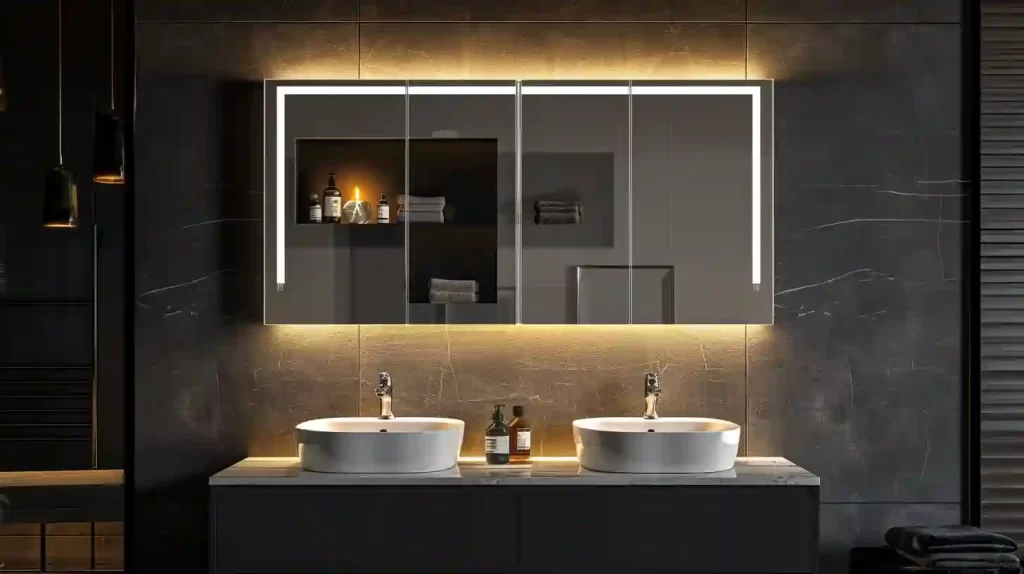
When selecting a bathroom mirror cabinet, attention to the cabinet’s aesthetics is paramount alongside door materials and opening mechanisms. Various design elements and styles directly influence the cabinet’s appearance and overall decor effect. Here’s a breakdown of key considerations:
2.2.1. Design Elements:
When selecting a bathroom mirror cabinet, attention to design elements is crucial as they directly influence its aesthetics and overall decor effect:
- Lines and Contours: For instance, a minimalist modern-style cabinet may boast crisp lines and sleek geometric shapes, emphasizing simplicity and contemporary flair.
- Decorative Details: Ornamental details like carvings, inlays, and patterns can add unique personality. A traditionally-styled cabinet might feature elaborate carvings and vintage-inspired decor.
- Hardware Selection: Handles, pulls, and other hardware play crucial roles in design. A modern-style cabinet might opt for minimalist metal handles, while a traditional one might choose antique bronze pulls for a vintage touch.
- Color and Finish: Color choice and finishing significantly impact the cabinet’s appearance. For example, a bright white finish can enhance spaciousness and freshness, while darker tones can create a warm and luxurious ambiance.
2.2.2. Design Styles:
Design style plays a crucial role in the appearance and atmosphere of a bathroom mirror cabinet. Here are several common design styles that can add unique style and personality to your mirror cabinet.
- Modern Style: A modern-style cabinet often features clean lines and smooth surfaces, prioritizing functionality and chic aesthetics.
- Traditional Style: Conversely, a traditional-style cabinet may focus more on decorative details and vintage-inspired design, evoking classic elegance.
- Industrial Style: Industrial-style cabinets may combine metal and wood elements, emphasizing raw and practical aesthetics.
- Modern Minimalist Style: Cabinets in this style tend to prioritize simplicity and functionality, avoiding excessive decorative details for a clean and streamlined look.
2.2.3. Personalized Customization:
Consider personalized customization options to tailor your cabinet to perfection:
- Custom Options: Choosing personalized customization services allows tailoring cabinets to individual preferences and bathroom space characteristics. For example, specific colors, materials, and design elements can be selected to create a unique cabinet.
- Space Utilization: Custom cabinets can maximize storage space and practicality based on bathroom dimensions and needs. Tailored sizes and structures can be crafted to suit the space efficiently.
- Brand Selection: Opting for reputable brands offering customization ensures design and service quality. High-end brands provide extensive customization options and professional design teams.
By considering these design elements and styles, you can create personalized bathroom mirror cabinets that not only reflect your preferences but also complement and enhance your bathroom decor style effectively.
3. Connecting Function and Aesthetics:
Exploring the Connection Between Mirror Cabinet Bodies and Doors
As we investigate the anatomy of a mirrored cabinet in more depth, it is necessary to comprehend its essential components that contribute to its functionality and visual appeal. One such key element is the connection between cabinet body and doors – an element which not only determines structural integrity but also greatly impacts ease of use and overall design aesthetic. We will examine hinges and piano hinges’ contributions towards smooth operation while adding coherence in cabinet designs; let’s discover how these components bridge functional requirements with aesthetic considerations in mirror cabinet designs!
3.1. Exploring Soft Closing Hinge: Essential Components in Mirror Cabinet Design
Soft closing hinges play a vital role in ensuring the functionality and durability of mirror cabinets, the importance and variations of which are explored below:
- Functionality: Soft Closing Hinges act as a fulcrum to allow the doors to open and close smoothly. They provide easy access to the contents of the cabinets while ensuring secure closure so that items are neatly stored and protected.
- Durability: The quality of the soft close hinge directly affects the service life of the mirror cabinet. High-quality soft close hinges made of durable materials such as stainless steel or brass ensure long-lasting performance even when used frequently in a humid bathroom environment.
- Design Considerations: Soft close hinges help to enhance the overall aesthetics of a mirror cabinet. They are available in a variety of finishes and styles, and designers can choose options to match the design theme of the mirror cabinet (modern, traditional or industrial).
- Types of Soft closing hinge:
- Concealed Soft Close Hinge: This soft close hinge is installed inside the cabinet and is not visible when the door is closed, giving it a sleek and minimalist appearance.
- Surface-mounted soft hinges: surface-mounted soft hinges are visible on the outside of the cabinet, adding a decorative element to the cabinet design.
- Soft-Close Hinges: Soft-close hinges feature a soft-close hinge that slows down the closing action of the cabinet door, prevents slamming noises, and reduces wear and tear on the cabinet and the soft-close hinge.
- Adjustable Soft-Close Hinges: Adjustable soft-close hinges allow for fine-tuning of the door alignment to ensure a perfect fit and smooth operation.
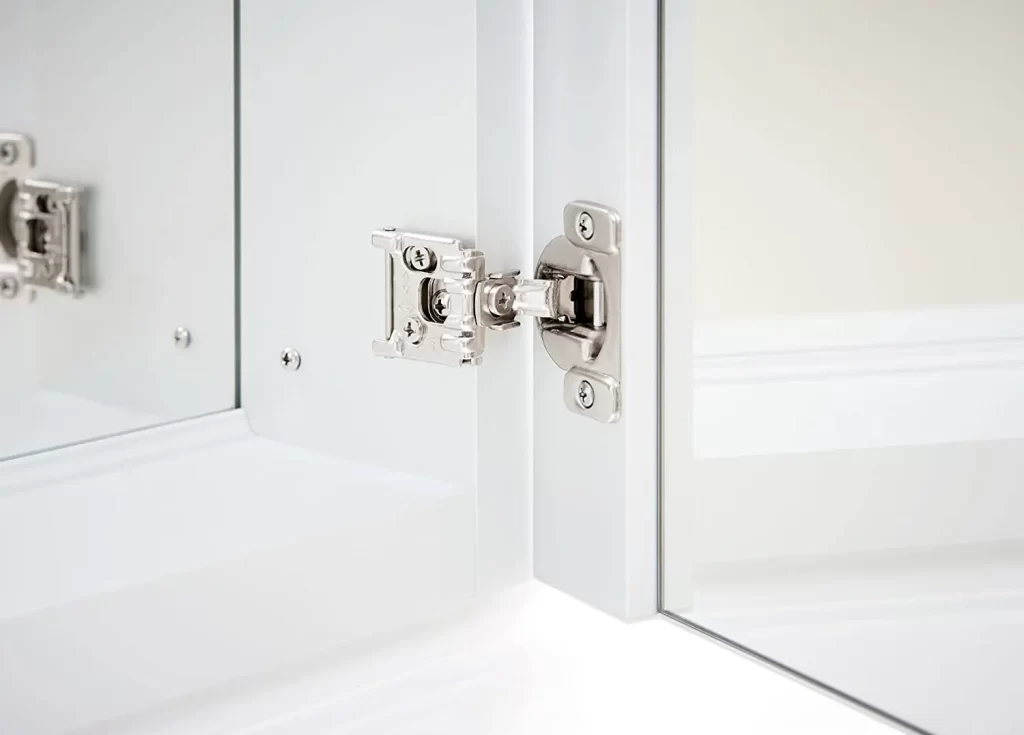
5. Installation and Maintenance: Installation and regular maintenance are both essential in ensuring Soft closing hinge function optimally over time. They should be secured firmly and adjusted as necessary for smooth operation, and routine cleaning/lubrication helps avoid rust while guaranteeing smooth performance.
By understanding the importance of Soft closing hinge and selecting the right type for your mirror cabinet, you can enhance both its functionality and aesthetic appeal, contributing to a well-designed and long-lasting bathroom storage solution.
3.2. Understanding Piano Hinges: Enhancing Mirror Cabinet Functionality and Style
Piano hinges (commonly known as continuous hinges) are long, narrow hinges that run the entire length of a cabinet door and offer distinct advantages. They significantly increase functionality and aesthetics in mirror cabinets – here’s more information on their applications:
3.2.1. Functionality:
Piano hinges play a critical role in enhancing the functionality and longevity of bathroom mirror cabinets. Here’s how:
- Smooth Operation: Piano hinges provide uniform support along the entire length of the door, ensuring smooth and stable opening and closing. This consistent movement is particularly beneficial for larger or heavier doors, which might otherwise experience sagging or misalignment over time.
- Increased Durability: By distributing the weight of the door evenly, piano hinges reduce stress on any single point. This even weight distribution enhances the overall durability of both the door and the hinge mechanism.
Piano hinges are a preferred choice for bathroom mirror cabinets due to their reliable performance and ability to withstand frequent use. Their design promotes smooth operation and durability, making them ideal for maintaining the functionality and aesthetics of your cabinet doors over time.
3.2.2. Design Considerations:
Building upon their functional benefits, piano hinges also contribute significantly to the design and aesthetic appeal of bathroom mirror cabinets:
- Sleek Appearance: Piano hinges offer a clean, streamlined look since they are often less visible than traditional hinges. When the door is closed, the continuous hinge line can be nearly invisible, contributing to a minimalist and modern aesthetic.
- Versatility: These hinges are versatile and can be used in various design styles, from contemporary to classic. They can be integrated seamlessly into the design without disrupting the cabinet’s visual flow.
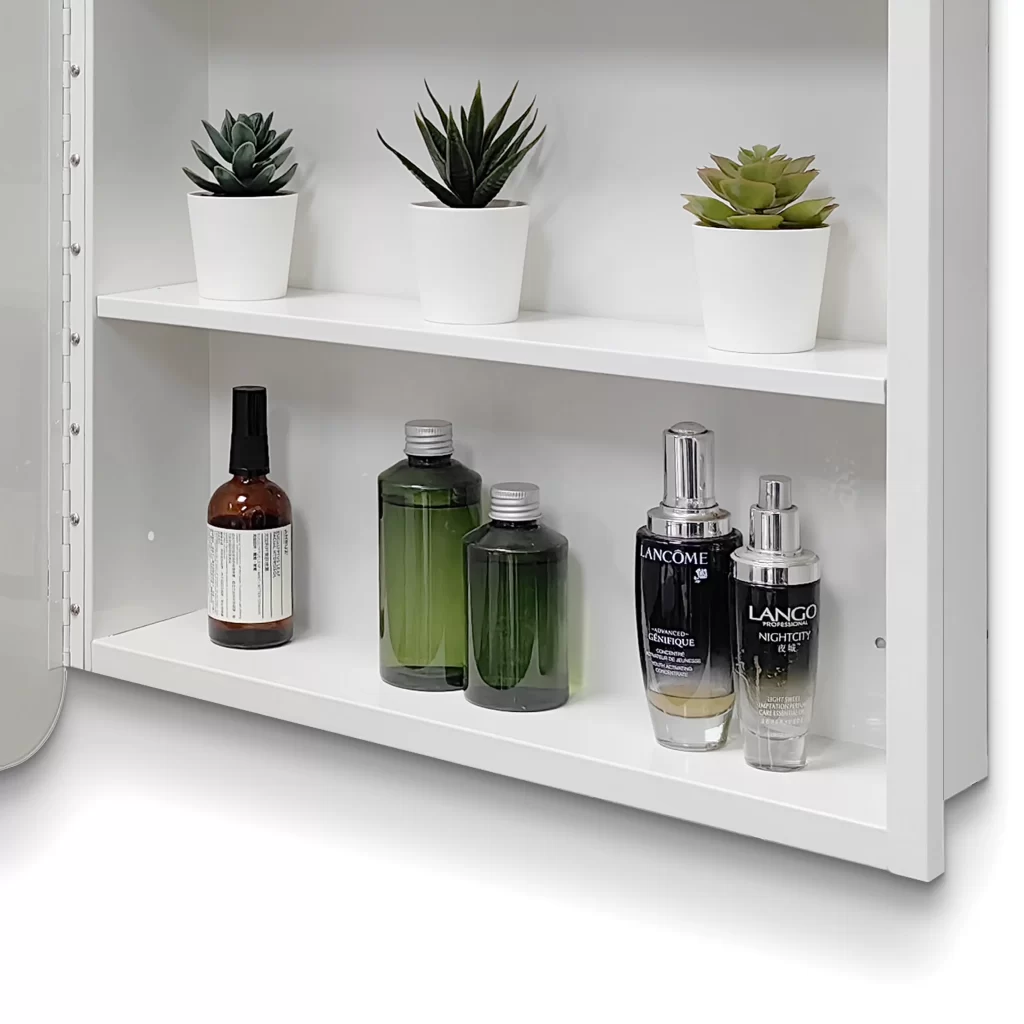
3.2.3. Types of Piano Hinges:
Piano hinges come in various types, each suited for different door sizes and weights:
- Full-Length Piano Hinges: These hinges run the entire length of the door, providing maximum support and stability. They are ideal for large, heavy doors that require robust support.
- Partial-Length Piano Hinges: Used for smaller or lighter doors, these hinges offer the benefits of piano hinges without the need for full-length support.
3.2.4. Installation and Maintenance:
Proper installation and maintenance are crucial for ensuring optimal performance of piano hinges:
- Precision Installation: Proper installation of piano hinges requires precision to ensure smooth and uniform movement. The hinge must be aligned accurately along the door and cabinet body.
- Regular Maintenance: To maintain optimal performance, piano hinges should be regularly checked for alignment and lubricated to ensure smooth operation. This maintenance helps prevent wear and prolongs the life of the hinge.
3.2.5. Applications:
Piano hinges are versatile and suitable for various applications:
- Heavy Duty Use: Piano hinges are particularly suited for heavy-duty applications where the door is frequently used, such as in commercial settings or high-traffic areas in the home.
- Aesthetic Appeal: For those seeking a sleek, uninterrupted look, piano hinges provide a visually appealing solution that complements the clean lines of modern design.
By incorporating piano hinges into your mirror cabinet design, you can achieve a blend of functionality and style. These hinges not only enhance the durability and smooth operation of the cabinet doors but also contribute to a sophisticated and streamlined appearance, making them a valuable choice for any bathroom mirror cabinet.
3.3. Materials for Mirror Cabinet Shelves: Enhancing Utility and Style
The choice of material for the shelves inside your mirror cabinet is crucial for both functionality and aesthetics. Different materials offer varying benefits in terms of durability, maintenance, and visual appeal. Here’s a detailed look at some popular materials used for mirror cabinet shelves:
3.3.1. Glass Shelves
Features and Benefits:
- Elegant Appearance: Glass shelves provide a sleek and modern look, adding a touch of elegance to any bathroom.
- Easy Maintenance: They are easy to clean and maintain, simply requiring regular wiping with a glass cleaner to keep them sparkling.
- Visibility: Glass shelves offer high visibility of stored items, making it easy to find what you need quickly.
- Light Reflection: They enhance the reflection of light within the cabinet, making the interior brighter and more visually appealing.
Considerations:
- Fragility: While tempered glass is strong and durable, it can still break under extreme stress or impact.
- Weight Capacity: Glass shelves might have a lower weight capacity compared to metal shelves, so they are best suited for lighter items.
3.3.2. Powder-Coated Iron Shelves
Features and Benefits:
- Durability: Powder-coated iron shelves are extremely durable and can withstand heavy use. The powder coating adds an extra layer of protection against corrosion and wear.
- Cost-Effective: These shelves are generally more affordable compared to stainless steel, offering a budget-friendly option without sacrificing quality.
- Variety of Colors: Powder-coated iron shelves come in various colors, allowing for customization to match your bathroom’s decor.
Considerations:
- Maintenance: Although they are resistant to rust, regular cleaning and occasional maintenance are necessary to prevent any potential damage over time.
- Weight: Iron shelves are heavier than glass or stainless steel, so ensure the cabinet structure can support their weight.
3.3.3. Stainless Steel Shelves
Features and Benefits:
- High Durability: Stainless steel shelves are incredibly strong and resistant to rust, making them ideal for humid bathroom environments.
- Low Maintenance: These shelves are easy to clean and maintain, requiring minimal effort to keep them looking new.
- Modern Look: Stainless steel offers a sleek, contemporary appearance that complements modern bathroom designs.
- Hygienic: Stainless steel is non-porous and resistant to bacteria, making it a hygienic option for storing bathroom essentials.
Considerations:
- Cost: Stainless steel shelves can be more expensive than other options, reflecting their high durability and premium look.
- Surface Scratches: While they are resistant to most forms of damage, stainless steel shelves can show scratches more visibly than other materials.
Selecting the optimal material for your mirror cabinet shelves depends on your unique needs and preferences. Glass shelves offer a sophisticated yet contemporary aesthetic, ideal for showcasing items. Powder-coated iron shelves offer durability with various color options at more reasonable costs; and stainless steel shelves bring strength, low maintenance costs and contemporary appeal making them suitable choices for any bathroom setting.
By carefully considering the characteristics and benefits of each material, you can select shelves to enhance both functionality and style in your mirror cabinet.
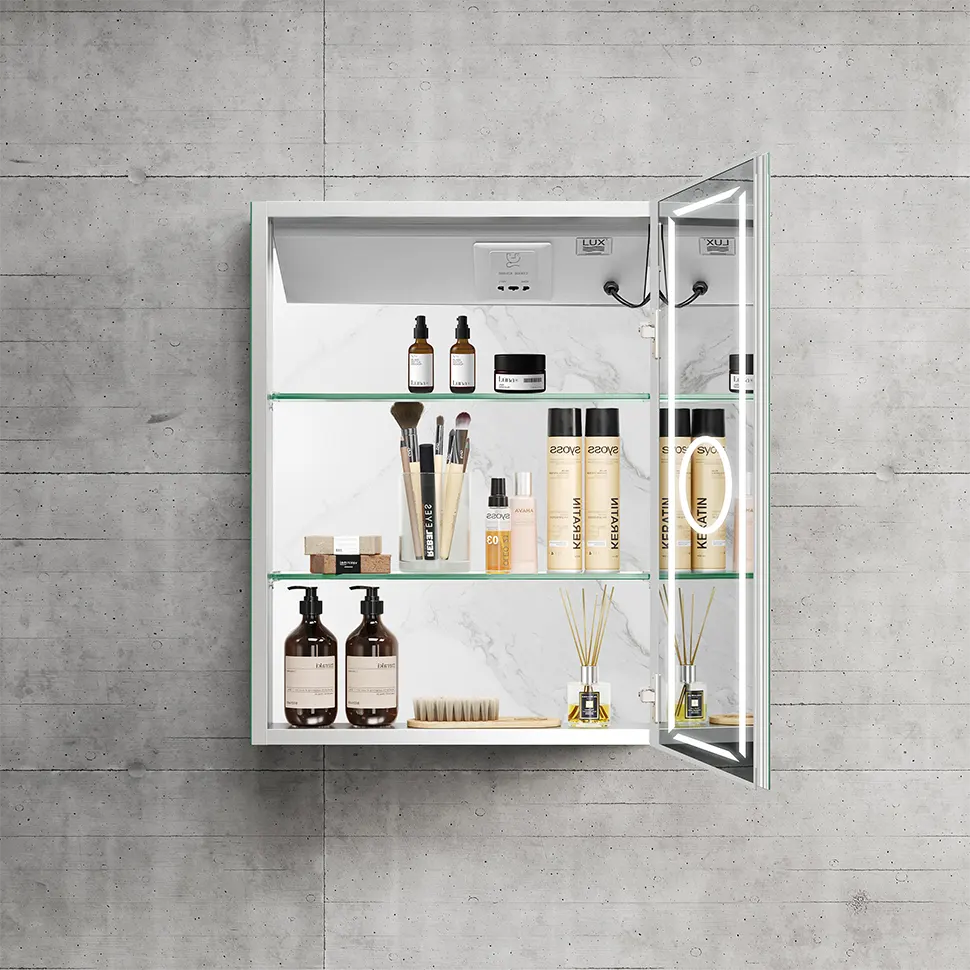
4. Interactive Element: Choose the Best Bathroom Mirror Cabinet for Your Needs
|
Bathroom Features/Preferences |
Recommended Materials |
Recommended Door Styles |
|
Modern Minimalist |
Aluminum Alloy, Stainless Steel |
Sliding Door |
|
Traditional Vintage |
Solid Wood, Powder-Coated Iron |
Outward Opening Door |
|
Industrial Style |
Stainless Steel, Powder-Coated Iron |
Sliding Door or Continuous Hinge Door |
|
Natural Country |
Solid Wood |
Outward Opening Door |
|
Key Features |
Recommended Materials |
|
Easy to Clean and Maintain |
Aluminum Alloy, Stainless Steel |
|
Aesthetic and Decorative |
Solid Wood, Powder-Coated Iron |
|
Durability and Strength |
Stainless Steel, Aluminum Alloy |
|
Eco-Friendly and Natural Feel |
Solid Wood |
Instructions:
- Identify your bathroom style from the table and find the corresponding recommended materials and door styles.
- Consider the characteristic you value the most to further refine your choices.
- Choose the appropriate door style based on the size of your bathroom space.
This table helps readers quickly and conveniently find the most suitable bathroom mirror cabinet design for their specific needs.
5. Conclusion
Throughout this guide we have explored various aspects of bathroom mirror cabinets, from their door materials and opening mechanisms, cabinet body materials and design as well as internal shelving materials and their connection hardware. Here is a brief recap of some key points discussed.
- Door Materials: Including solid wood, metals such as stainless steel, aluminum alloy, and powder-coated iron, each with its unique advantages and suitable applications.
- Opening Mechanisms: Evaluated the practicality and aesthetics of different door opening methods like sliding doors, flip doors, and folding doors.
- Cabinet Body Materials: Covered materials like solid wood, stainless steel, aluminum alloy, and powder-coated iron, emphasizing their durability, aesthetic appeal, and maintenance requirements.
- Hinges and Piano Hinges: Detailed the importance of hinges and piano hinges in connecting the cabinet body and door, highlighting their role in ensuring smooth operation and long-lasting functionality.
- Shelf Materials: Compared glass, powder-coated iron, and stainless steel shelves, discussing their benefits, drawbacks, and ideal usage scenarios.
By carefully choosing the right materials and design elements, you can create a bathroom mirror cabinet that perfectly suits your needs and reflects your personal style. This not only enhances the functionality of your bathroom but also adds a touch of elegance and charm to your space.
Take the next step today by reaching out to design experts or beginning to plan your mirror cabinet upgrade. Whether you prefer a modern, minimalist look or a classic, timeless design, your choices can make a significant difference in transforming your bathroom into a sanctuary of style and practicality. Start exploring and bring your dream bathroom to life!
6. FAQ:
- What are the different materials and durability considerations for mirror cabinets?
- Common materials for mirror cabinets include stainless steel, aluminum alloy, solid wood, or MDF board. Consider waterproofing and durability when choosing.
- Stainless steel and aluminum alloy are more durable in humid environments, while solid wood or MDF board may require additional moisture protection.
- How do I effectively clean and maintain a mirror cabinet?
- Use a soft damp cloth to gently wipe the mirror surface and cabinet exterior, avoiding harsh cleaning agents.
- Regularly check and clean seals to maintain waterproofing.
- What lighting options are available for mirror cabinets?
- Modern mirror cabinets often come with LED lighting, providing bright and energy-efficient illumination.
- Options include touch or motion sensor switches for easy operation and improved user experience.
- Is there a relationship between the price and quality of mirror cabinets?
- The price of mirror cabinets typically correlates with material, size, design, and additional features. Higher prices often indicate better quality and more features.
- Choose a mirror cabinet within your budget while ensuring it meets basic usage and safety requirements.
- Do mirror cabinets require specialized skills for installation and maintenance?
- Installation involves wall mounting and electrical connections. If unsure, it’s advisable to seek professional assistance to ensure safety and correctness.
- Maintenance may involve replacing electrical components and light fixtures, which should ideally be done by a qualified technician.